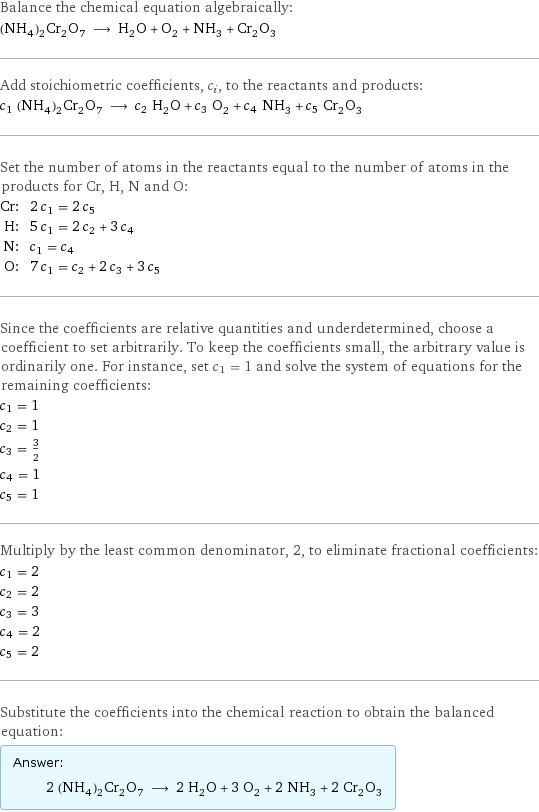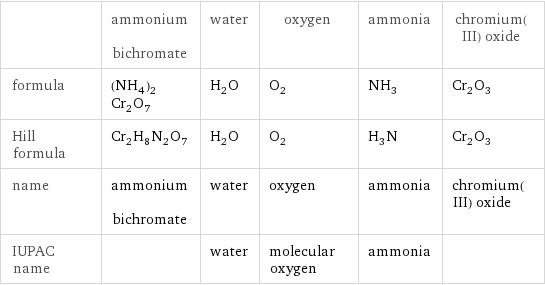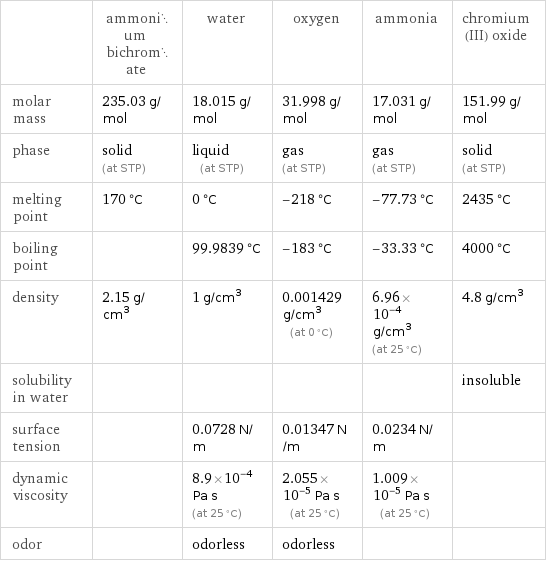Input interpretation

(NH_4)_2Cr_2O_7 ammonium bichromate ⟶ H_2O water + O_2 oxygen + NH_3 ammonia + Cr_2O_3 chromium(III) oxide
Balanced equation

Balance the chemical equation algebraically: (NH_4)_2Cr_2O_7 ⟶ H_2O + O_2 + NH_3 + Cr_2O_3 Add stoichiometric coefficients, c_i, to the reactants and products: c_1 (NH_4)_2Cr_2O_7 ⟶ c_2 H_2O + c_3 O_2 + c_4 NH_3 + c_5 Cr_2O_3 Set the number of atoms in the reactants equal to the number of atoms in the products for Cr, H, N and O: Cr: | 2 c_1 = 2 c_5 H: | 5 c_1 = 2 c_2 + 3 c_4 N: | c_1 = c_4 O: | 7 c_1 = c_2 + 2 c_3 + 3 c_5 Since the coefficients are relative quantities and underdetermined, choose a coefficient to set arbitrarily. To keep the coefficients small, the arbitrary value is ordinarily one. For instance, set c_1 = 1 and solve the system of equations for the remaining coefficients: c_1 = 1 c_2 = 1 c_3 = 3/2 c_4 = 1 c_5 = 1 Multiply by the least common denominator, 2, to eliminate fractional coefficients: c_1 = 2 c_2 = 2 c_3 = 3 c_4 = 2 c_5 = 2 Substitute the coefficients into the chemical reaction to obtain the balanced equation: Answer: | | 2 (NH_4)_2Cr_2O_7 ⟶ 2 H_2O + 3 O_2 + 2 NH_3 + 2 Cr_2O_3
Structures

⟶ + + +
Names

ammonium bichromate ⟶ water + oxygen + ammonia + chromium(III) oxide
Equilibrium constant
![Construct the equilibrium constant, K, expression for: (NH_4)_2Cr_2O_7 ⟶ H_2O + O_2 + NH_3 + Cr_2O_3 Plan: • Balance the chemical equation. • Determine the stoichiometric numbers. • Assemble the activity expression for each chemical species. • Use the activity expressions to build the equilibrium constant expression. Write the balanced chemical equation: 2 (NH_4)_2Cr_2O_7 ⟶ 2 H_2O + 3 O_2 + 2 NH_3 + 2 Cr_2O_3 Assign stoichiometric numbers, ν_i, using the stoichiometric coefficients, c_i, from the balanced chemical equation in the following manner: ν_i = -c_i for reactants and ν_i = c_i for products: chemical species | c_i | ν_i (NH_4)_2Cr_2O_7 | 2 | -2 H_2O | 2 | 2 O_2 | 3 | 3 NH_3 | 2 | 2 Cr_2O_3 | 2 | 2 Assemble the activity expressions accounting for the state of matter and ν_i: chemical species | c_i | ν_i | activity expression (NH_4)_2Cr_2O_7 | 2 | -2 | ([(NH4)2Cr2O7])^(-2) H_2O | 2 | 2 | ([H2O])^2 O_2 | 3 | 3 | ([O2])^3 NH_3 | 2 | 2 | ([NH3])^2 Cr_2O_3 | 2 | 2 | ([Cr2O3])^2 The equilibrium constant symbol in the concentration basis is: K_c Mulitply the activity expressions to arrive at the K_c expression: Answer: | | K_c = ([(NH4)2Cr2O7])^(-2) ([H2O])^2 ([O2])^3 ([NH3])^2 ([Cr2O3])^2 = (([H2O])^2 ([O2])^3 ([NH3])^2 ([Cr2O3])^2)/([(NH4)2Cr2O7])^2](../image_source/f8325dc23fed65722e8adaaaddfd40ce.png)
Construct the equilibrium constant, K, expression for: (NH_4)_2Cr_2O_7 ⟶ H_2O + O_2 + NH_3 + Cr_2O_3 Plan: • Balance the chemical equation. • Determine the stoichiometric numbers. • Assemble the activity expression for each chemical species. • Use the activity expressions to build the equilibrium constant expression. Write the balanced chemical equation: 2 (NH_4)_2Cr_2O_7 ⟶ 2 H_2O + 3 O_2 + 2 NH_3 + 2 Cr_2O_3 Assign stoichiometric numbers, ν_i, using the stoichiometric coefficients, c_i, from the balanced chemical equation in the following manner: ν_i = -c_i for reactants and ν_i = c_i for products: chemical species | c_i | ν_i (NH_4)_2Cr_2O_7 | 2 | -2 H_2O | 2 | 2 O_2 | 3 | 3 NH_3 | 2 | 2 Cr_2O_3 | 2 | 2 Assemble the activity expressions accounting for the state of matter and ν_i: chemical species | c_i | ν_i | activity expression (NH_4)_2Cr_2O_7 | 2 | -2 | ([(NH4)2Cr2O7])^(-2) H_2O | 2 | 2 | ([H2O])^2 O_2 | 3 | 3 | ([O2])^3 NH_3 | 2 | 2 | ([NH3])^2 Cr_2O_3 | 2 | 2 | ([Cr2O3])^2 The equilibrium constant symbol in the concentration basis is: K_c Mulitply the activity expressions to arrive at the K_c expression: Answer: | | K_c = ([(NH4)2Cr2O7])^(-2) ([H2O])^2 ([O2])^3 ([NH3])^2 ([Cr2O3])^2 = (([H2O])^2 ([O2])^3 ([NH3])^2 ([Cr2O3])^2)/([(NH4)2Cr2O7])^2
Rate of reaction
![Construct the rate of reaction expression for: (NH_4)_2Cr_2O_7 ⟶ H_2O + O_2 + NH_3 + Cr_2O_3 Plan: • Balance the chemical equation. • Determine the stoichiometric numbers. • Assemble the rate term for each chemical species. • Write the rate of reaction expression. Write the balanced chemical equation: 2 (NH_4)_2Cr_2O_7 ⟶ 2 H_2O + 3 O_2 + 2 NH_3 + 2 Cr_2O_3 Assign stoichiometric numbers, ν_i, using the stoichiometric coefficients, c_i, from the balanced chemical equation in the following manner: ν_i = -c_i for reactants and ν_i = c_i for products: chemical species | c_i | ν_i (NH_4)_2Cr_2O_7 | 2 | -2 H_2O | 2 | 2 O_2 | 3 | 3 NH_3 | 2 | 2 Cr_2O_3 | 2 | 2 The rate term for each chemical species, B_i, is 1/ν_i(Δ[B_i])/(Δt) where [B_i] is the amount concentration and t is time: chemical species | c_i | ν_i | rate term (NH_4)_2Cr_2O_7 | 2 | -2 | -1/2 (Δ[(NH4)2Cr2O7])/(Δt) H_2O | 2 | 2 | 1/2 (Δ[H2O])/(Δt) O_2 | 3 | 3 | 1/3 (Δ[O2])/(Δt) NH_3 | 2 | 2 | 1/2 (Δ[NH3])/(Δt) Cr_2O_3 | 2 | 2 | 1/2 (Δ[Cr2O3])/(Δt) (for infinitesimal rate of change, replace Δ with d) Set the rate terms equal to each other to arrive at the rate expression: Answer: | | rate = -1/2 (Δ[(NH4)2Cr2O7])/(Δt) = 1/2 (Δ[H2O])/(Δt) = 1/3 (Δ[O2])/(Δt) = 1/2 (Δ[NH3])/(Δt) = 1/2 (Δ[Cr2O3])/(Δt) (assuming constant volume and no accumulation of intermediates or side products)](../image_source/936818784e7147121770b15ad4831659.png)
Construct the rate of reaction expression for: (NH_4)_2Cr_2O_7 ⟶ H_2O + O_2 + NH_3 + Cr_2O_3 Plan: • Balance the chemical equation. • Determine the stoichiometric numbers. • Assemble the rate term for each chemical species. • Write the rate of reaction expression. Write the balanced chemical equation: 2 (NH_4)_2Cr_2O_7 ⟶ 2 H_2O + 3 O_2 + 2 NH_3 + 2 Cr_2O_3 Assign stoichiometric numbers, ν_i, using the stoichiometric coefficients, c_i, from the balanced chemical equation in the following manner: ν_i = -c_i for reactants and ν_i = c_i for products: chemical species | c_i | ν_i (NH_4)_2Cr_2O_7 | 2 | -2 H_2O | 2 | 2 O_2 | 3 | 3 NH_3 | 2 | 2 Cr_2O_3 | 2 | 2 The rate term for each chemical species, B_i, is 1/ν_i(Δ[B_i])/(Δt) where [B_i] is the amount concentration and t is time: chemical species | c_i | ν_i | rate term (NH_4)_2Cr_2O_7 | 2 | -2 | -1/2 (Δ[(NH4)2Cr2O7])/(Δt) H_2O | 2 | 2 | 1/2 (Δ[H2O])/(Δt) O_2 | 3 | 3 | 1/3 (Δ[O2])/(Δt) NH_3 | 2 | 2 | 1/2 (Δ[NH3])/(Δt) Cr_2O_3 | 2 | 2 | 1/2 (Δ[Cr2O3])/(Δt) (for infinitesimal rate of change, replace Δ with d) Set the rate terms equal to each other to arrive at the rate expression: Answer: | | rate = -1/2 (Δ[(NH4)2Cr2O7])/(Δt) = 1/2 (Δ[H2O])/(Δt) = 1/3 (Δ[O2])/(Δt) = 1/2 (Δ[NH3])/(Δt) = 1/2 (Δ[Cr2O3])/(Δt) (assuming constant volume and no accumulation of intermediates or side products)
Chemical names and formulas

| ammonium bichromate | water | oxygen | ammonia | chromium(III) oxide formula | (NH_4)_2Cr_2O_7 | H_2O | O_2 | NH_3 | Cr_2O_3 Hill formula | Cr_2H_8N_2O_7 | H_2O | O_2 | H_3N | Cr_2O_3 name | ammonium bichromate | water | oxygen | ammonia | chromium(III) oxide IUPAC name | | water | molecular oxygen | ammonia |
Substance properties

| ammonium bichromate | water | oxygen | ammonia | chromium(III) oxide molar mass | 235.03 g/mol | 18.015 g/mol | 31.998 g/mol | 17.031 g/mol | 151.99 g/mol phase | solid (at STP) | liquid (at STP) | gas (at STP) | gas (at STP) | solid (at STP) melting point | 170 °C | 0 °C | -218 °C | -77.73 °C | 2435 °C boiling point | | 99.9839 °C | -183 °C | -33.33 °C | 4000 °C density | 2.15 g/cm^3 | 1 g/cm^3 | 0.001429 g/cm^3 (at 0 °C) | 6.96×10^-4 g/cm^3 (at 25 °C) | 4.8 g/cm^3 solubility in water | | | | | insoluble surface tension | | 0.0728 N/m | 0.01347 N/m | 0.0234 N/m | dynamic viscosity | | 8.9×10^-4 Pa s (at 25 °C) | 2.055×10^-5 Pa s (at 25 °C) | 1.009×10^-5 Pa s (at 25 °C) | odor | | odorless | odorless | |
Units
